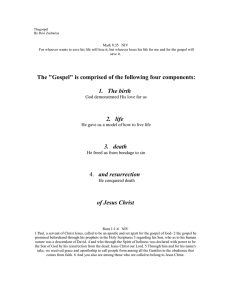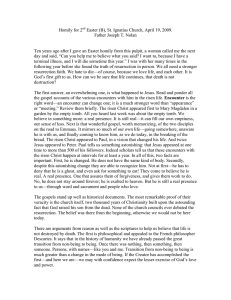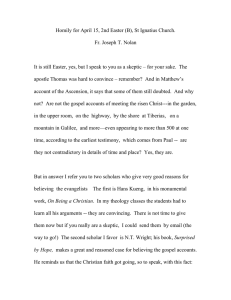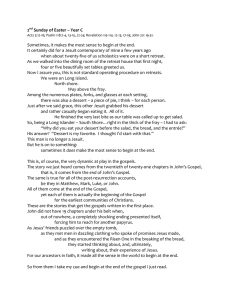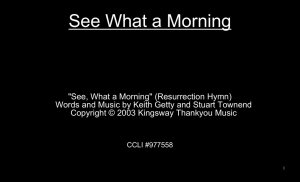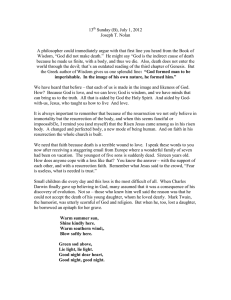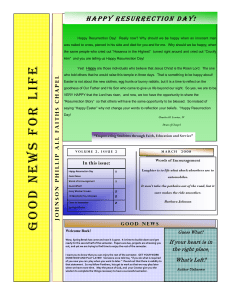A Homily for 6 Easter (A), May 4, 2008
advertisement
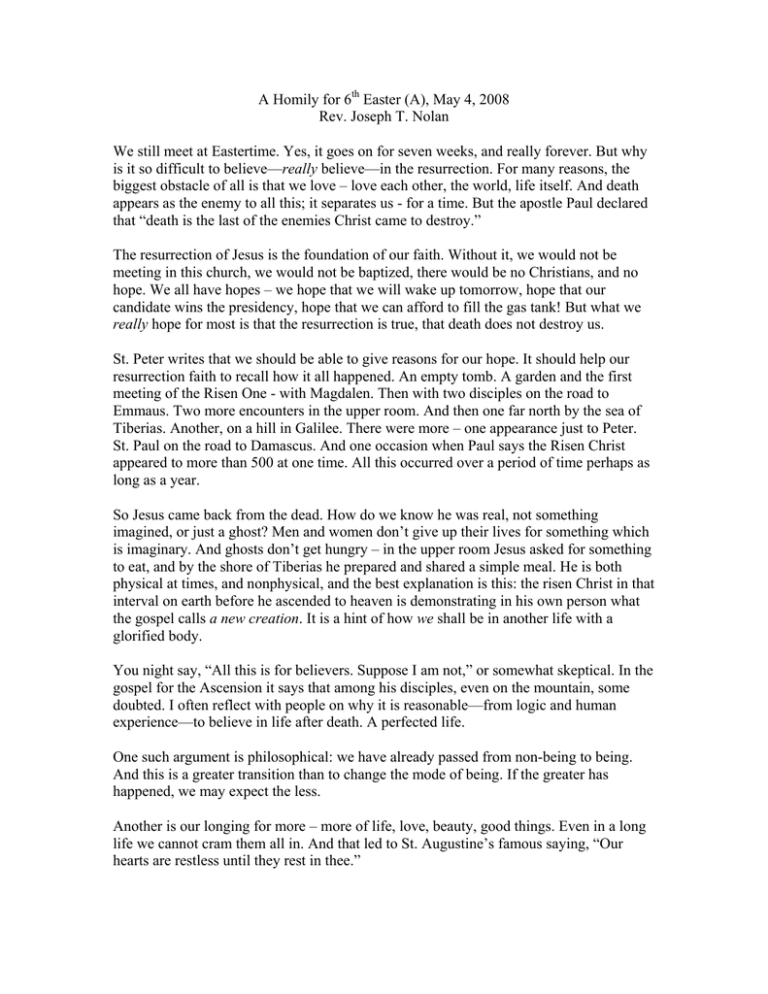
A Homily for 6th Easter (A), May 4, 2008 Rev. Joseph T. Nolan We still meet at Eastertime. Yes, it goes on for seven weeks, and really forever. But why is it so difficult to believe—really believe—in the resurrection. For many reasons, the biggest obstacle of all is that we love – love each other, the world, life itself. And death appears as the enemy to all this; it separates us - for a time. But the apostle Paul declared that “death is the last of the enemies Christ came to destroy.” The resurrection of Jesus is the foundation of our faith. Without it, we would not be meeting in this church, we would not be baptized, there would be no Christians, and no hope. We all have hopes – we hope that we will wake up tomorrow, hope that our candidate wins the presidency, hope that we can afford to fill the gas tank! But what we really hope for most is that the resurrection is true, that death does not destroy us. St. Peter writes that we should be able to give reasons for our hope. It should help our resurrection faith to recall how it all happened. An empty tomb. A garden and the first meeting of the Risen One - with Magdalen. Then with two disciples on the road to Emmaus. Two more encounters in the upper room. And then one far north by the sea of Tiberias. Another, on a hill in Galilee. There were more – one appearance just to Peter. St. Paul on the road to Damascus. And one occasion when Paul says the Risen Christ appeared to more than 500 at one time. All this occurred over a period of time perhaps as long as a year. So Jesus came back from the dead. How do we know he was real, not something imagined, or just a ghost? Men and women don’t give up their lives for something which is imaginary. And ghosts don’t get hungry – in the upper room Jesus asked for something to eat, and by the shore of Tiberias he prepared and shared a simple meal. He is both physical at times, and nonphysical, and the best explanation is this: the risen Christ in that interval on earth before he ascended to heaven is demonstrating in his own person what the gospel calls a new creation. It is a hint of how we shall be in another life with a glorified body. You night say, “All this is for believers. Suppose I am not,” or somewhat skeptical. In the gospel for the Ascension it says that among his disciples, even on the mountain, some doubted. I often reflect with people on why it is reasonable—from logic and human experience—to believe in life after death. A perfected life. One such argument is philosophical: we have already passed from non-being to being. And this is a greater transition than to change the mode of being. If the greater has happened, we may expect the less. Another is our longing for more – more of life, love, beauty, good things. Even in a long life we cannot cram them all in. And that led to St. Augustine’s famous saying, “Our hearts are restless until they rest in thee.” Another argument for an eternity of happiness is the unfairness of life. That is especially true for people who die young, or who suffer greatly, or experience other tragedies. Surely a just God will make up for this. And the real bottom line here is that life is always a gift, no matter what happens. Especially if the gift is open ended. And a final one, perhaps the most persuasive, is our experience of love. Love is never satisfied with death, love cannot accept that we will not be united again and know God even as we are known. Thus the Hebrew scriptures call love “a flame of Yahweh,” a fire that many waters cannot extinguish.” There is still sin and human failure. But over all our failing is the divine mercy. Remember the great line from Jeremiah speaking for God: “I will forgive all their wrong doing, I will not remember their sins anymore.” The gospel today reflects the thinking of the community who wrote it, that we are not abandoned or forsaken when the glorified Jesus returns to heaven. The answer for them is a presence of the one they called the paraclete, the spirit of truth. But they also present Jesus as saying, “I will not leave you orphaned; I will come back to you.” The real focus here is the presence of God in our lives. The number of ways this is described is almost bewildering. The theologian speaks of the divine immanence, the God within as well as above. Then there is the whole doctrine of grace. There is the connection to love, also from John: “He who abides in love abides in God, and God in him.” And the full understanding of the risen Christ is no longer limited by his physical body, and can be so close to us that we are even called members of this body. And listen to this from John: “I abide in my Father, and you in me, and I in you.” This closeness of God, expressed any way you wish, is compared by mystics to the fish in water, the ground on which we walk, the very air we breathe. The biblical writer used air, or breath, as the symbol of God giving us life, breathing into us. The air, by which we live, is invisible. And, as one scholar noted, air has no color; if it did, we would not be able to see anything else. God, by whom we live, is invisible. And yet, the spirit of wisdom, the spirit of truth enables us to see into have insight to the mysteries of life and death, heaven and God. The Holy Spirit. The Risen Christ. Indeed we are not left orphans – we are as close to God as a child in a parent’s arms. And for the same reason: we are loved.
